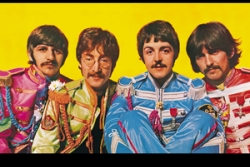

If I recall correctly, I was in the 6th grade when I begged my mom to buy for me my first 45 RPM record. That quirky tune, Baby Sittin’ Boogie by Buzz Clifford (1961), proved the genesis of my ongoing love affair with Rock ‘n’ Roll music from the 60s and 70s. As my musical appetite blossomed, I spent most of my allowance and the small amount of cash earned mowing lawns on comic books and those marvelous pancake-sized plastic disks with the large hole in the middle, known as 45’s. The melodic trends of those bygone days would drastically change over the next 10 years, along with my musical preferences.
Many of the top hits from ’61 to ’63 were sung by trusted familiar names such as Elvis, Pat Boone, Chubby Checker Neil Sedaka, The 4 Seasons, Lesley Gore and Ray Charles. Then in ’64 the Beatles unleashed the British Invasion with an energizing new sound from across the pond. Around the same time The Beach Boys introduced surf rock with a string of megahits glorifying coastal California, blonde beach chicks, cruising, surfing and a little old lady from Pasadena. Rock music would never be the same. Often I would sit in my room for long stretches switching channels on my transistor radio from KFWB to KHJ to KRLA hoping to hear the latest hits from the Byrds, Rolling Stones, Sonny & Cher, Mama’s & Papa’s and the Supremes. I remember that two of the songs I couldn’t hear enough of were “The House of the Rising Sun” by The Animals or “Do Wah Diddy Diddy” by Manfred Mann. In ’65 Barry McGuire climbed the charts with a tune that would open the floodgates for protest songs for years to come—“Eve of Destruction.” It took me only two days to memorize the words from this somber hit, and I still remember every word today. Thus began what I consider to be the greatest 10 years of rock (1964-1974) music ever.
I graduated from high school in June of 1967, the “Summer of Love.” The Summer of Love was a social phenomenon that occurred during the summer of 1967, when as many as 100,000 people converged in the Haight- Ashbury neighborhood of San Francisco. Although hippies also gathered in major cities across the U.S., Canada and Europe, San Francisco remained the epicenter of the social earthquake that would come to be known as the Hippie Revolution. With the summer of ’67 came an avalanche of diverse tuneful hits. Those included “Light My Fire” (The Doors), “The Letter” (Box Tops), “Groovin’” (Young Rascals), “Ruby Tuesday” (Rolling Stones) and “Respect” (Aretha Franklin). The late ‘60s proved a cornucopia of mystic sights and sounds that has never been duplicated since. Then, two years later in 1969, exploded the granddaddy of all concerts, Woodstock. Unfortunately I happened to be in Vietnam at that time, and we soldiers knew nothing about the sea of humanity gathered to witness the greatest collection of rock stars ever assembled.
In Vietnam music transcended every aspect of military life. Blasting tunes for hours every day from your reel-to-reel tape player was a mandatory act for all discontented GI’s! Every grunt had a tape player in their hooch, as well as a turntable (record player) connected to massive Sansui or Teac speakers. The bigger the speakers the better chance you had of blasting out the twang of country music seeping in from the hooch next door, or the soul tunes piercingly vibrating from across the street. The two constants in Nam were countrywide: the desire to get home and blaring music at all hours of the day and night. Often brawls broke out over insults directed at someone’s choice of music or trying to get a drugged out GI to turn down his sound system. I believe my 22 months in Vietnam had the most profound influence over my musical preferences. I am still amazed today when a tune comes on the radio that I haven’t heard in 10 to 20 years; however I somehow still remember every word from the golden oldie. Long live rock ‘n’ roll, especially from the ‘60s and ‘70s!
Pete Whalon, author of “The Siagon Zoo” has called Southern California home since age five.
